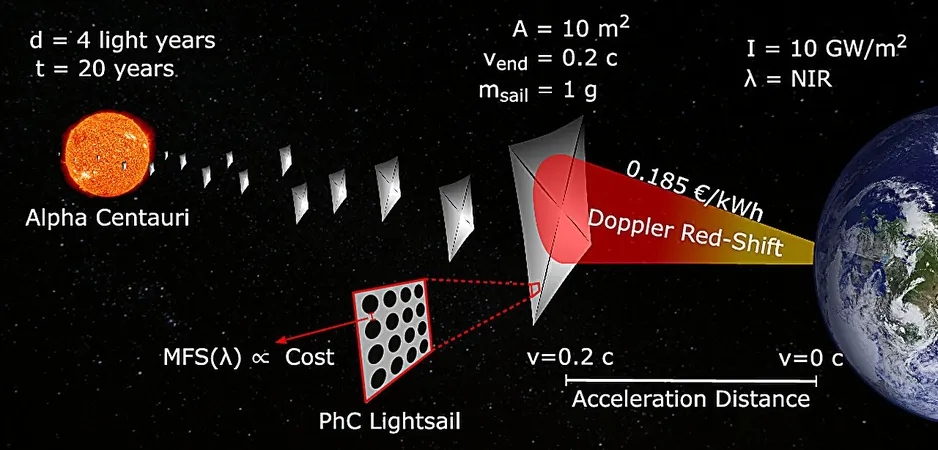
Groundbreaking Lightsail Technology Could Revolutionize Interstellar Travel!
2025-03-30
Author: Li
Groundbreaking Lightsail Technology Could Revolutionize Interstellar Travel!
In an astonishing breakthrough for the future of space exploration, researchers have devised an incredibly thin and highly reflective membrane that may potentially allow small spacecraft to journey to the stars at unprecedented speeds.
NASA’s Voyager 1 spacecraft, launched in 1977, has traveled an impressive 15 billion miles into the cosmos. While that’s an impressive feat, it's still less than 1% of the distance to Alpha Centauri, the closest star system to our own. To make interstellar travel a reality, we need to accelerate spacecraft significantly beyond current capabilities.
Enter the concept of the “lightsail” — a lightweight, reflective membrane that harnesses the power of light, much like how wind propels a sailboat. Lightsails could dramatically reduce travel time to nearby stellar systems from many thousands of years to just a decade or two, revolutionizing our approach to space travel.
A collaborative team of researchers from Brown University and Delft University of Technology (TU Delft) has unveiled a pioneering design and fabrication technique for these ultra-thin lightsails. Their findings, published in Nature Communications, showcase a lightsail membrane measuring only 60mm by 60mm, with a staggering thickness of just 200 nanometers — a fraction of a human hair's width.
The unique structure features billions of nanoscale holes, which significantly reduce the weight of the membrane while enhancing its reflectivity and acceleration potential. “This work represents a joint effort between theorists at Brown University and experimentalists at TU Delft, enabling us to design and fabricate a highly reflective lightsail with the largest aspect ratio ever documented," explained Miguel Bessa, an associate professor at Brown University.
The research aligns with aspirations like those of the Starshot Breakthrough Initiative, established by visionary entrepreneur Yuri Milner and the late Stephen Hawking. This initiative aims to utilize ground-based lasers to propel meter-scale lightsails equipped with microchip-sized spacecraft, and the innovative design presented by the researchers could easily be scaled up to meet these ambitious goals.
Employing single-layer silicon nitride — a lightweight and resilient material — the researchers prioritized maximizing reflectivity while minimizing weight. The interplay between reflectivity and material weight is crucial, as higher reflectivity generates increased light pressure, accelerating the sail, while a lighter build requires less force to achieve greater speeds.
The optimization involved designing a myriad of nanoscale holes across the surface, each smaller than the wavelength of light. Bessa's team incorporated a sophisticated artificial intelligence method to perfect the shape and arrangement of these holes to optimize both reflectivity and weight.
Once the design was finalized, the experimental team at TU Delft utilized an innovative gas-based etching process to carefully craft the lightsail. “This unique technique allows us to selectively remove material without compromising the integrity of the sail,” noted Richard Norte, another lead researcher. Remarkably, what could have taken years and significant financial resources to fabricate using traditional methods was accomplished in about a day and at a fraction of the cost.
The resulting membrane boasts the highest aspect ratio of any lightsail design thus far. The implications of this work extend beyond just interstellar travel; it could also propel advancements in nanoscale engineering across various fields.
As Bessa highlighted, “The machine learning and optimization techniques we've developed are versatile. They may unlock solutions to numerous engineering challenges that have remained unsolvable until now.” This latest innovation not only brings humanity closer to the stars but also sets the stage for a new era of technological advancements that could reshape our understanding of physics and engineering.
With continued support and development, the dream of exploring distant star systems may soon transform from fantasy into reality!


 Brasil (PT)
Brasil (PT)
 Canada (EN)
Canada (EN)
 Chile (ES)
Chile (ES)
 Česko (CS)
Česko (CS)
 대한민국 (KO)
대한민국 (KO)
 España (ES)
España (ES)
 France (FR)
France (FR)
 Hong Kong (EN)
Hong Kong (EN)
 Italia (IT)
Italia (IT)
 日本 (JA)
日本 (JA)
 Magyarország (HU)
Magyarország (HU)
 Norge (NO)
Norge (NO)
 Polska (PL)
Polska (PL)
 Schweiz (DE)
Schweiz (DE)
 Singapore (EN)
Singapore (EN)
 Sverige (SV)
Sverige (SV)
 Suomi (FI)
Suomi (FI)
 Türkiye (TR)
Türkiye (TR)
 الإمارات العربية المتحدة (AR)
الإمارات العربية المتحدة (AR)